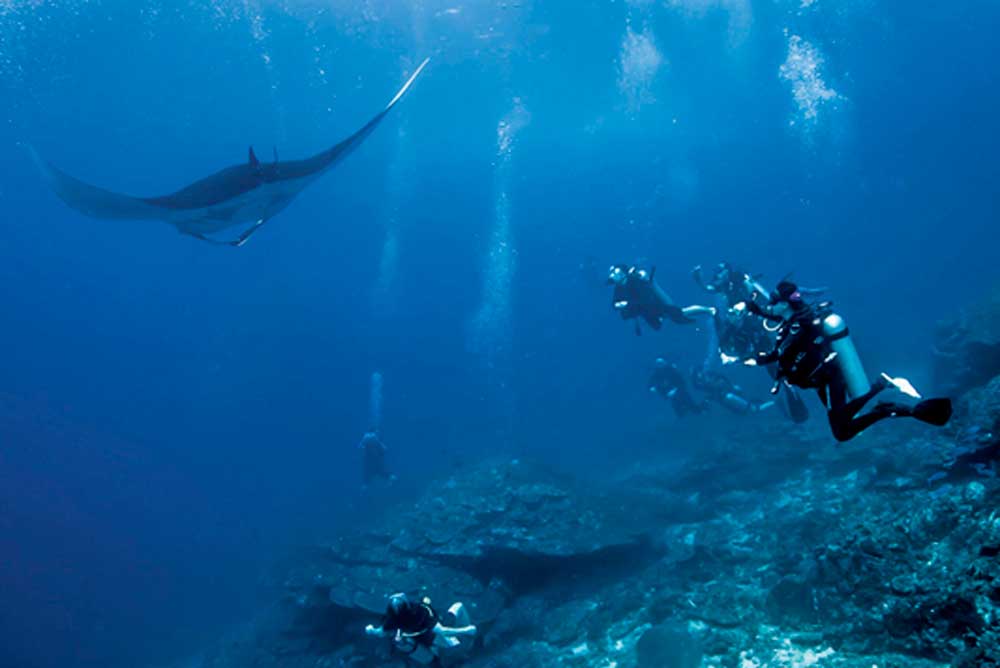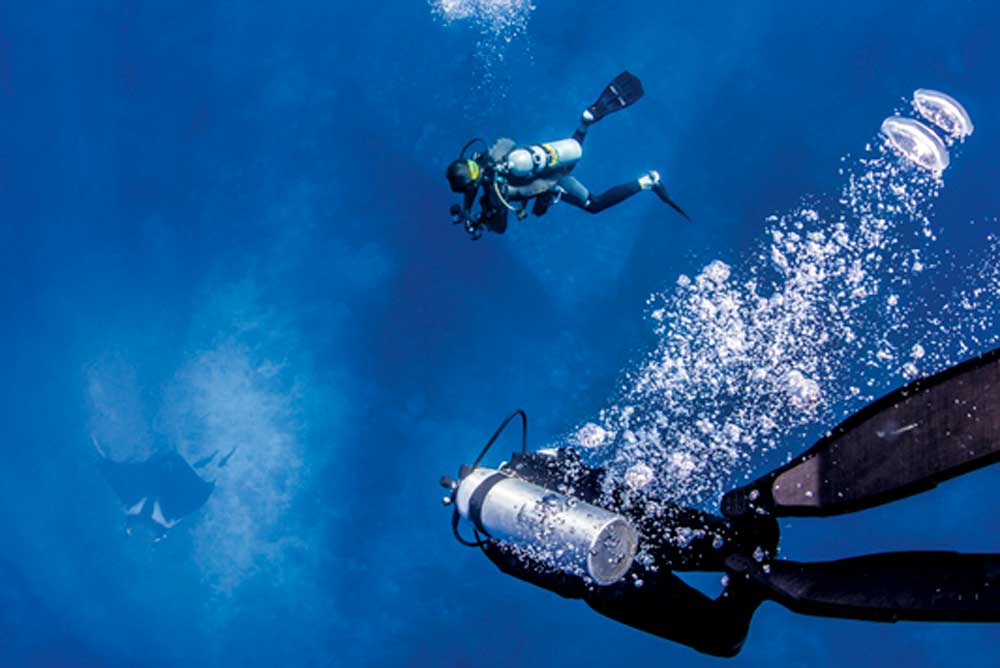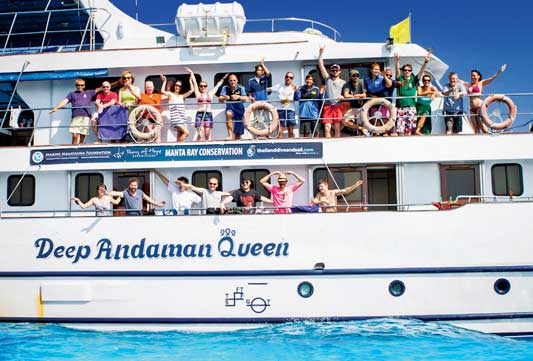Magnificent Manta Rays
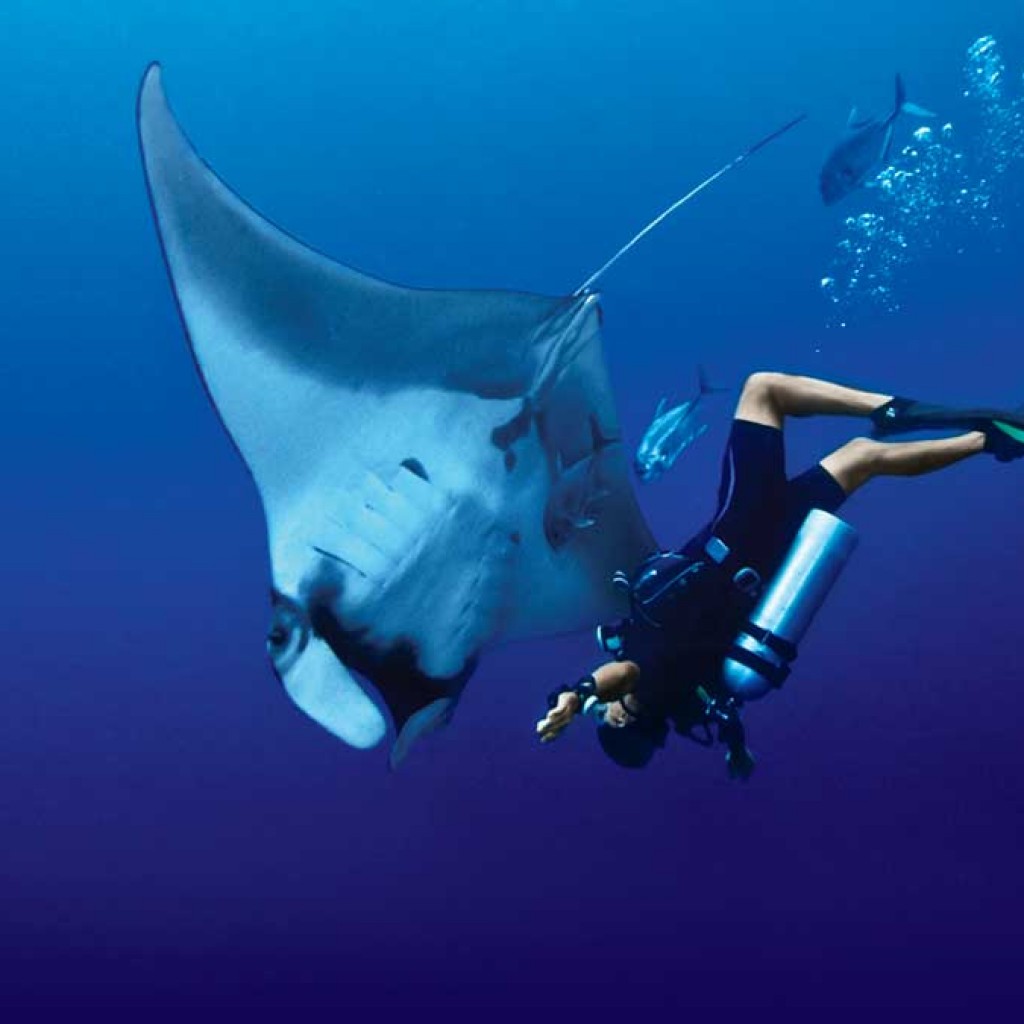
Manta rays are a big draw to the Khao Lak region for scuba divers from all around the world and if you are visiting Khao Lak for scuba diving or snorkelling you’ll probably have seen images or heard tales of manta rays (or ‘mantas’ for short), or even by now had the pleasure of an underwater encounter with these curious, bird-like giants of the ocean.
Mantas can be playful at times – swimming deliberately close to divers – but can also be shy and keep their distance, depending on their mood.
Despite their size, mantas are completely harmless, non-threatening and graceful – in short, they are magnificent.
5 Facts That Make Manta Rays So Magnificent
1
In common with all sharks, skates and rays, mantas are part of the ‘Elasmobranchs’ i.e. cartilaginous fish, meaning their skeletons are mostly comprised of cartilage.This feature is what gives sharks their great mobility and what makes mantas so flexible and their movements so graceful.2
Manta rays are one of the most hydrodynamic animals in the ocean.The U.S. military modelled the stealth bomber on a Manta’s body shape.3
Mantas are the largest of all living rays.They can eat up to 15% of their body weight a week and feeding on a diet of plankton has allowed them to achieve extraordinary sizes – in some parts of the world they can grow to a disc width of 8 metres. The largest encountered in Thai waters are around 5 metres.4
Manta rays also have the largest brain in relation to their body size compared to any other fish in the ocean.The reason for this has puzzled sci- entists for a long time, but recent research indicates that mantas have set themselves apart as extremely social animals, with very complex and coordinated feeding and reproductive behaviour. Like terrestrial animals, development of strong social behaviour leads to an increase in brain size.5
Mantas are not only very social with one another but also with other animals, even scuba divers.They display a special type of inquisitive behaviour not found in similar species such as sharks.Manta Ray Evolution
Manta rays have evolved from the stingray family, but their evolutionary departure from stingrays is very, very dramatic. In terms of body shape and composition almost everything has changed in a manta. Not only has the circular shape of the stingray elongated out to form huge wings, but also the position of the eyes has moved to a lateral position on the sides of a manta’s head.
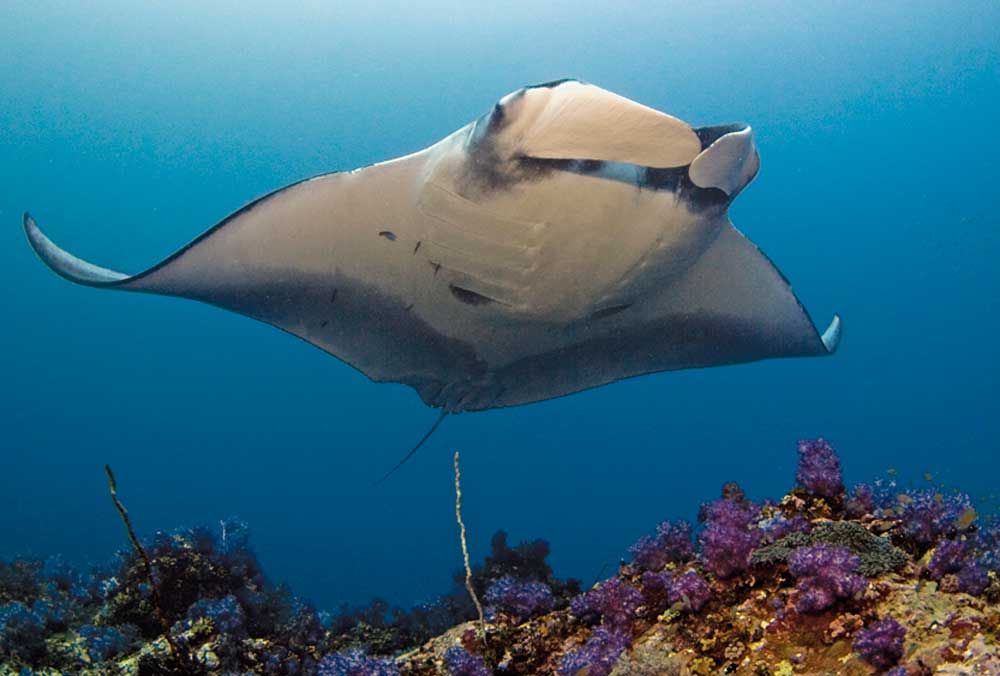
A male giant manta ray at the Black Rock dive site in Myanmar – one of the stops on Dr. Fabrice Jaine’s ‘Ray of Hope’ expedition in February 2015. (See below) Photo © Dr. Andrea Marshall
Instead of having a mouth underneath their body like stingrays, the mouth of a manta ray has migrated up to the end of their head.A vital evolutionary step when you look at the feeding habits of a manta.The mouth can be expanded into a huge, cavernous opening which is able to funnel a lot of water through it and thus with it their food.
Like other megafauna species such as whales, whale sharks and basking sharks, manta rays feed predominantly on plankton, more specifically zooplankton.They filter plankton from the water using modified gill rakers.These gill rakers serve two purposes, firstly to sieve out their food from the water and secondly, to clean the water which is then passed over their gills allowing them to extract oxygen and breathe like all other fish.
Diving with Manta Rays
Diving with these incredible creatures is one of those memorable moments in life that you can never forget, and if you are lucky enough to encounter one they can have a very profound effect.
Anyone who has done so will often talk of a mesmerising, humbling or even intimate experience, leaving divers with the feeling they made a connection with a creature of high intelligence.
The best time of year to dive with manta rays is usually between January and March although in recent years there are increasingly more sightings at all times throughout the Similan diving season. The two best known locations are at Koh Bon and Koh Tachai though sightings are not always predicable. Mantas sometimes show up in the Similan Islands and at Richelieu Rock.
Encounters are also common further south near Koh Lanta at Hin Daeng and Hin Muang dive sites.
To date, Black Rock dive site in Myanmar has the highest number of manta encounters in any given day. Dr Marshall positively identified over 30 different individuals there over four dives.
All Khao Lak dive centres running day trips to the Similan Islands include at least one dayʼs diving at Koh Bon in their weekly schedules. Four and five day Similan liveaboard trips departing from Khao Lak include both Koh Bon and Koh Tachai on their itineraries.
Divers can also email manta@seeandsea.org for more details about diving with manta rays from Khao Lak and how to get involved with local manta research.
Diving with Mantas – a Code of Conduct
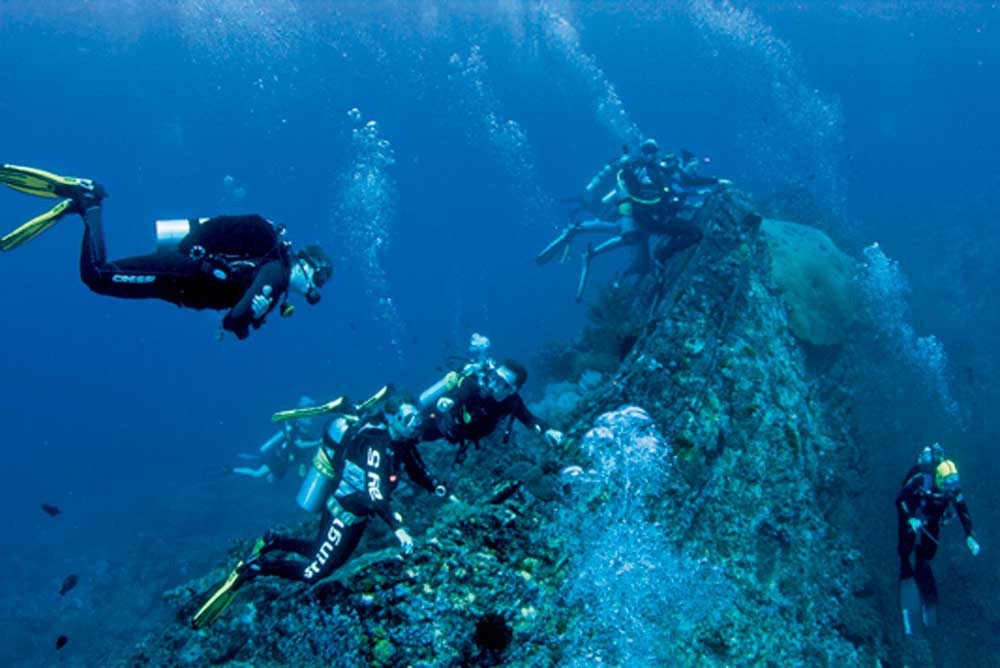
How NOT to do it. Divers cling to the Koh Bon Ridge in an attempt to prolong their giant manta ray encounter
Despite the curious, friendly nature of manta rays and the great encounters divers often experience, diving irresponsibly can have a negative effect on manta rays.
In some areas of the world it has even been reported that harassment by disrespectful divers has led to manta populations leaving a particular area.
It is essential to develop and sustain proper codes of conduct when diving with manta rays.
As responsible divers we should:
• Never chase or harass manta rays, swim directly at them or try to intercept their swimming direction.
• Always try to remain a few metres away from individuals and preferably below their eye level. Of course if a Manta decides it wants to come for a closer look at you, that’s okay, but it has to be on the manta’s terms not yours.
• Do not purge your regulator underneath a manta ray. Some mantas seem to enjoy diver’s bubbles on their bellies, others don’t. If the manta wants your bubbles to tickle it’s belly it will take charge of the situation, do not try to guess what they do and do not like.
• Do not harm the environment to improve your manta encounters. Sadly, it is common in strong currents to see recreational divers clinging to seafans and corals in order to prolong their manta encounters. Remember loss of habitat may also lead to mantas leaving a particular area.
• Stay away from any noticeable cleaning stations and stay well away from any manta being cleaned.
• Do try and photograph the underside of a manta, but not if it puts the animal, yourself or the environment at risk.
• Relax and enjoy the show. If the manta ray feels comfortable around divers, it may stick around for your whole dive. If you swim at the manta, say to get a photo or a closer look, it may swim away spoiling the enjoyment for many other divers in the water. A sure-fire way to lose popularity on any dive boat!
Studying Manta Rays
It is only really in the last ten years that we have begun to develop a greater understanding about manta rays.
At the forefront of this research is Dr Andrea Marshall (the BBC’s ‘Andrea – Queen of Mantas’ and National Geographic’s ‘Emerging Explorer of the Year’ in 2013) along with Dr Fabrice Jaine, her colleague at the Marine Megafauna Foundation.
It was not until 2009 that Dr Marshall made the remarkable discovery that there are actually two distinctive types of manta rays. Manta alfredi, commonly known as the reef manta and Manta birostris, commonly known as the giant manta.
Reef mantas are by far the most commonly encountered.They are the slightly smaller species of the two and tend to reside around certain areas for the entirety of their lives.
Giant manta rays are not only larger but tend to prefer deeper waters, travel greater distances and do not stay in any one place for long periods of time. As a result, there are very few locations in the world where tourists can dive with giant manta rays.The manta rays encountered diving from Khao Lak are giant mantas, making this a very unique place.
Both Dr Marshall and Dr Jaine have made frequent dives in the Andaman Sea to observe manta ray populations migrating through Thailand and Myanmar. Photographs of individual manta rays have shown that our populations are making long migrations in relatively short amounts of time, crossing international borders as they make their way north and south beneath the Andaman Sea.
Despite frequent sightings at certain times of the year and a huge increase in interest in manta rays there is still a lot to learn about these awesome creatures.
A common misconception with divers encountering mantas in Thailand is trying to pinpoint a reason why they are around, such as to clean themselves or to feed. Encounters with manta rays, especially with playful individuals, are perhaps more likely to be because the animal is as curious about us as we are about them. Many divers remark that when diving with a manta they weren’t sure exactly who was checking out who.
“When it comes to manta rays, there is something very interesting about the Similan, Surin and even Myanmar waters. Giant mantas are frequently encountered in the region, that is a fact, however we do not yet understand how they use these waters.
In most other places where manta rays occur, they will be there for a reason – to mate, clean at specific reefs or because there is a reliable food source – and will often have clearly defined seasonal migrations.
However, while the giant mantas are often observed cleaning on the reef here in the region, it does not appear like there are clearly identified ‘cleaning stations’ for them, and we do not know yet where they feed in the region. Plus we don’t know how many of them are out there!
These are the main questions behind our research and conservation efforts in the region.” – Dr. Fabrice Jaine
How divers can help with manta research
One of the best ways to study manta rays is through photography. Both types of manta have unique spot patterns on their undersides, especially in the area below their gills.These patterns act like a fingerprint that does not change throughout the manta’s lifespan. If you can capture the pattern of a particular manta then you have that animal’s identity for life.
Photographic identification not only helps in determining population sizes globally, but can also track manta ray migrations and the extent to which populations mix between regions.
It would be impossible for a few scientists to cover all manta aggregation sites on a regular basis so such research has become heavily dependent on input from regular,‘citizen scientist’ divers.
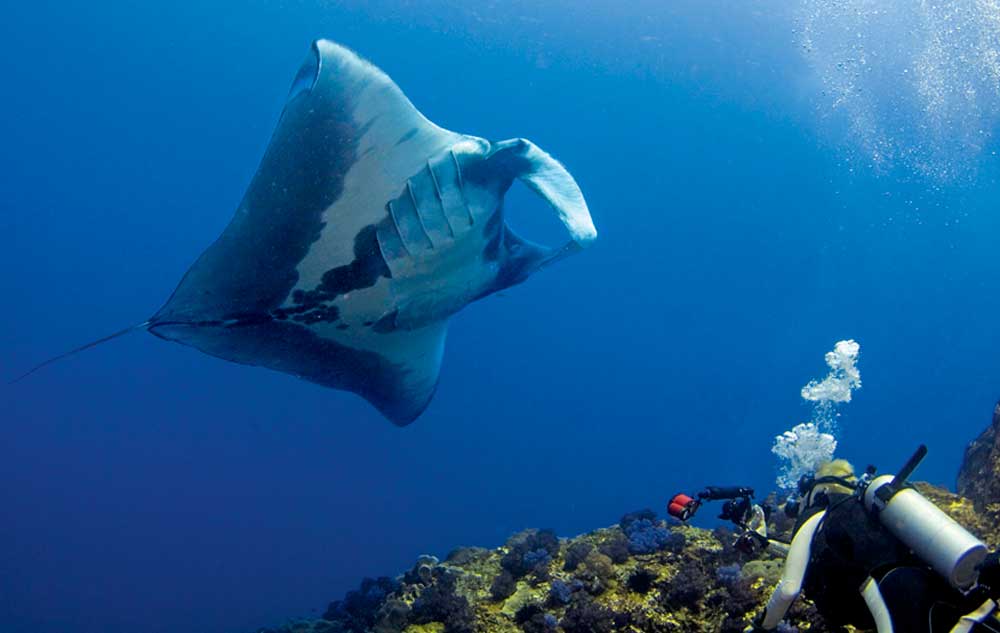
Expert underwater photographer Jannik D. Pedersen photographing giant mantas in the Andaman Sea. Like fingerprints in humans, the markings on each manta’s underside are unique to that animal. Photo © Dr. Andrea Marshall
Indeed, from Dr. Marshall’s initial idea Wild Me and other collaborators created Manta Matcher, an online global manta ray database. Anyone can now upload “belly shot” ID photos and check whether a manta has been seen before, and if so where.
One particular highlight of this kind of research was submitting a photo to Dr Marshall of a manta ray photographed at Koh Tachai on December 12, 2012. In February 2013, Dr Marshall photographed the very same manta whilst diving at Black Rock in Myanmar – proving that this manta (which she named ‘Diamond’) had made a northerly migration of over 260 km in just 70 days! This was a fascinating discovery and a great example of how we can all contribute to help manta research.
Manta ray presentation in Khao Lak
Dr Fabrice Jaine will be making a public presentation in Khao Lak all about manta rays on March 09, 2015, after returning from the Ray of Hope Expedition.
All are welcome to attend and learn more about these amazing animals. Further details about the venue and program will be released nearer to the event.
Check www.visitkhaolak.com, email manta@seeandsea.org or ask your Khao Lak dive centre nearer the time.
Join the 2015 ‘Ray of Hope’ manta research expedition!
Dr Fabrice Jaine will return to Khao Lak in February 2015 for an eight day dive trip which will visit some of the best known manta ray aggregation sites in Thailand and Myanmar and he welcomes divers, citizen scientists and manta lovers to join him.
More details on the Ray of Hope Expedition 2015.
Useful Website Links
Marine Megafauna Foundation
Web: Dr Andrea Marshall and Ray of Hope Expeditions and on Facebook.
Manta Matcher
Web: Manta Matcher and on Facebook.
Khao Lak Manta Research
The See and Sea Organisation and on Facebook.
Dr Fabrice Jaine
Web: Fabrice Jaine and on Facebook.
Featured image: As good as it gets. A diver enjoys a close encounter with a giant manta ray at Koh Bon in The Similan Islands. Photo © Jannik D. Pedersen


